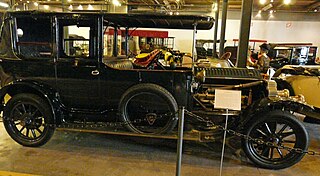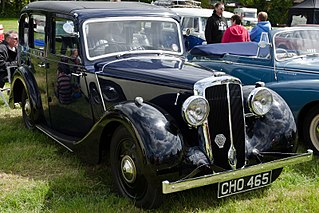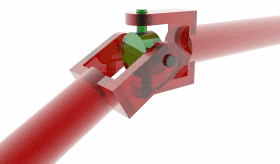
Tiny was a British cyclecar manufactured by Nanson, Barker & Co at Esholt, Yorkshire between 1912 and 1915.
The Lanchester Motor Company Limited was a car manufacturer located until early 1931 at Armourer Mills, Montgomery Street, Sparkbrook, Birmingham, and afterwards at Sandy Lane, Coventry England. The marque has been unused since the last Lanchester was produced in 1955. The Lanchester Motor Company Limited is still registered as an active company and accounts are filed each year, although as of 2014 it is marked as "non-trading".

Albion Motors was a Scottish automobile and commercial vehicle manufacturer.

The Rolls-Royce Silver Ghost name refers both to a car model and one specific car from that series.

Coventry Premier Limited owned a British car and cyclecar manufacturing business based in Coventry from 1912 to 1923. It changed its name from Premier Cycles to Coventry Premier Ltd in November 1914.

The Rolls-Royce Twenty built between 1922 and 1929 was Rolls-Royce's "small car" for the 1920s and was produced alongside the 40/50 Silver Ghost and the successor to the 40/50, the Phantom. It was intended to appeal to owner drivers but many were sold to customers with chauffeurs.
The Rover 8 was a small single-cylinder eight-horsepower 1327 cc car made by the British Rover car company. It was Rover's first production car. It was remarkable for having a backbone rather than a chassis. The first model was manufactured from 1904 to 1912, A Daimler-Knight sleeve-valve engine option was available in 1911 and 1912.

The Rover 6 was a small two-seater 6-horsepower car and only the second car model made by the British Rover car company. Announced in January 1905 a 6-horsepower car remained available from Rover until 1912.

The Austin 10 hp is a small car produced between 1910 and 1915 by the British car manufacturer Austin at their Longbridge, Worcestershire plant near Birmingham. 1,336 cars were made, 213 with the 1125 cc engine and 1,123 with the 1615 cc engine. Like the 1087 cc Austin 7 hp produced by both Austin and Du Cros's Swift Motor Company it was not very successful when sold with the small engine.

The Austin Light Twelve-Six is a 14 tax horsepower car with a 1496 cc engine that was introduced by Austin in January 1931. It was named by Austin Light Twelve to separate it from the well-established Austin Twelve. The general public then dubbed the original Twelve Heavy Twelve but Austin never used that name. The Light Twelve-Six remained in production until 1936.

The Rover 12 was a name given to several medium-sized family cars from the British Rover car company between 1905 and 1948.

The Vauxhall 30–98 is a car manufactured by Vauxhall at Luton, Bedfordshire from 1913 to 1927. In its day, its best-known configuration was the Vauxhall Velox standard 4-seater with open tourer body. Vauxhall's own description was the 30–98 hp Vauxhall-Velox sporting car. The 30–98 is also known to enthusiasts by Vauxhall's chassis code E.

The Vauxhall 27, 30 and 35 h.p. is a large six cylinder car manufactured by Vauxhall from 1910 to 1914. The 27 h.p. was Vauxhall's first six-cylinder car.
The Rover 16/50 and Rover 16 are mid-sized cars which were produced by Rover from 1926 to 1929 and non-continuously from 1936 to 1947 respectively.

The Lanchester Fourteen Roadrider, a new 6-cylinder Lanchester was announced by The Lanchester Motor Company Limited at the beginning of September 1936. The name Roadrider was chosen because of the special suspension features which were provided. It was stated to be the lowest priced six-cylinder Lanchester ever offered. This car replaced the previous 12 hp Light Six model with a larger six-cylinder engine again in the Lanchester Eleven chassis and body.

The Austin 40 hp is a 4-cylinder motor car launched at the Olympia Motor Show in November 1907. Manufactured by Austin at Longbridge, Northfield, Birmingham, it was the first variant from Austin's initial plans for a two model range of a 15 hp —which they had dropped—and a 25 hp car.
The Austin 15-20 is the smaller-engined of the almost identical pair of new cars announced by Herbert Austin in February 1906. A very complete catalogue with detailed specifications was issued at the same time. As well as the engine's smaller bore the 15-20 differed from the 25-30 by being only available with a live rear axle and not chain-drive. Otherwise the specifications were the same, the very minor differences are detailed below.

The Austin 15 hp is a 2.8-litre motor car manufactured by the British manufacturer Austin and first displayed at the seventh exhibition of motor vehicles which opened at London's Olympia in November 1908. Its tax rating was 20 horsepower. It was sold between 1908 and 1915.

The "bullnose" Morris Oxford is a series of motor car models produced by Morris of the United Kingdom, from 1913 to 1926. It was named by W R Morris after the city in which he grew up and which his cars were to industrialise.
The Austin 20-hp is a mid-sized car premium quality that was made by British manufacturer Austin and first displayed as a chassis in Paris in December 1912, advertised in March 1913 and shown to the public as a complete car at the Olympia Motor Show in November 1913. At that time both the 20 and the 30 were regarded as new models.




















